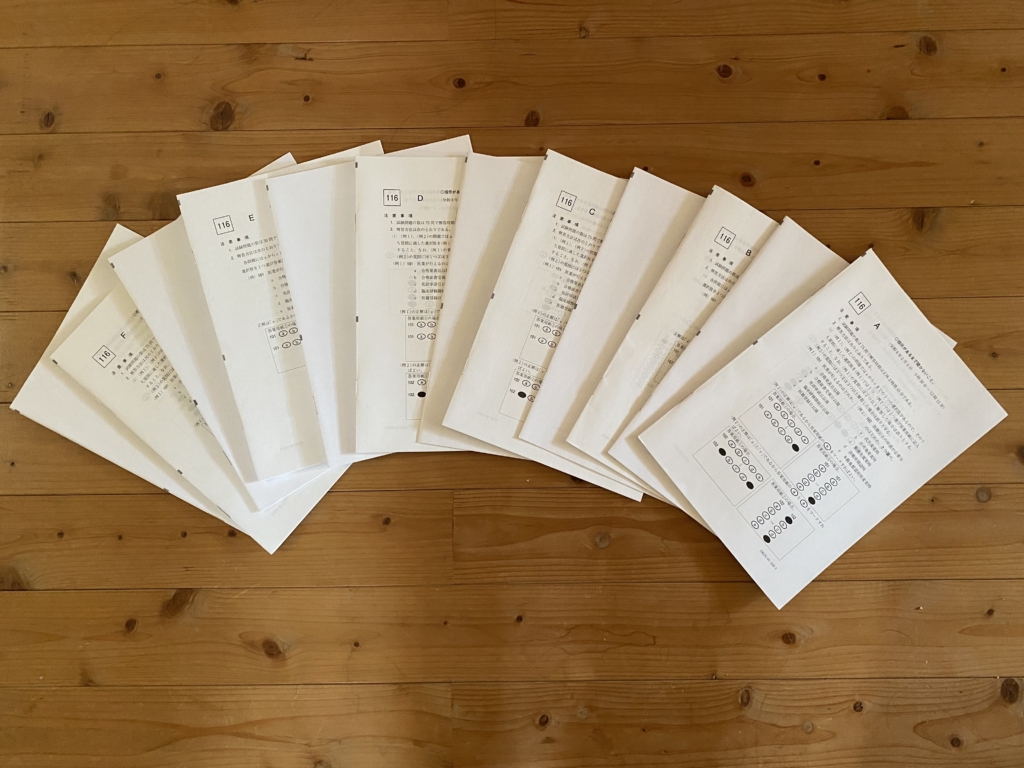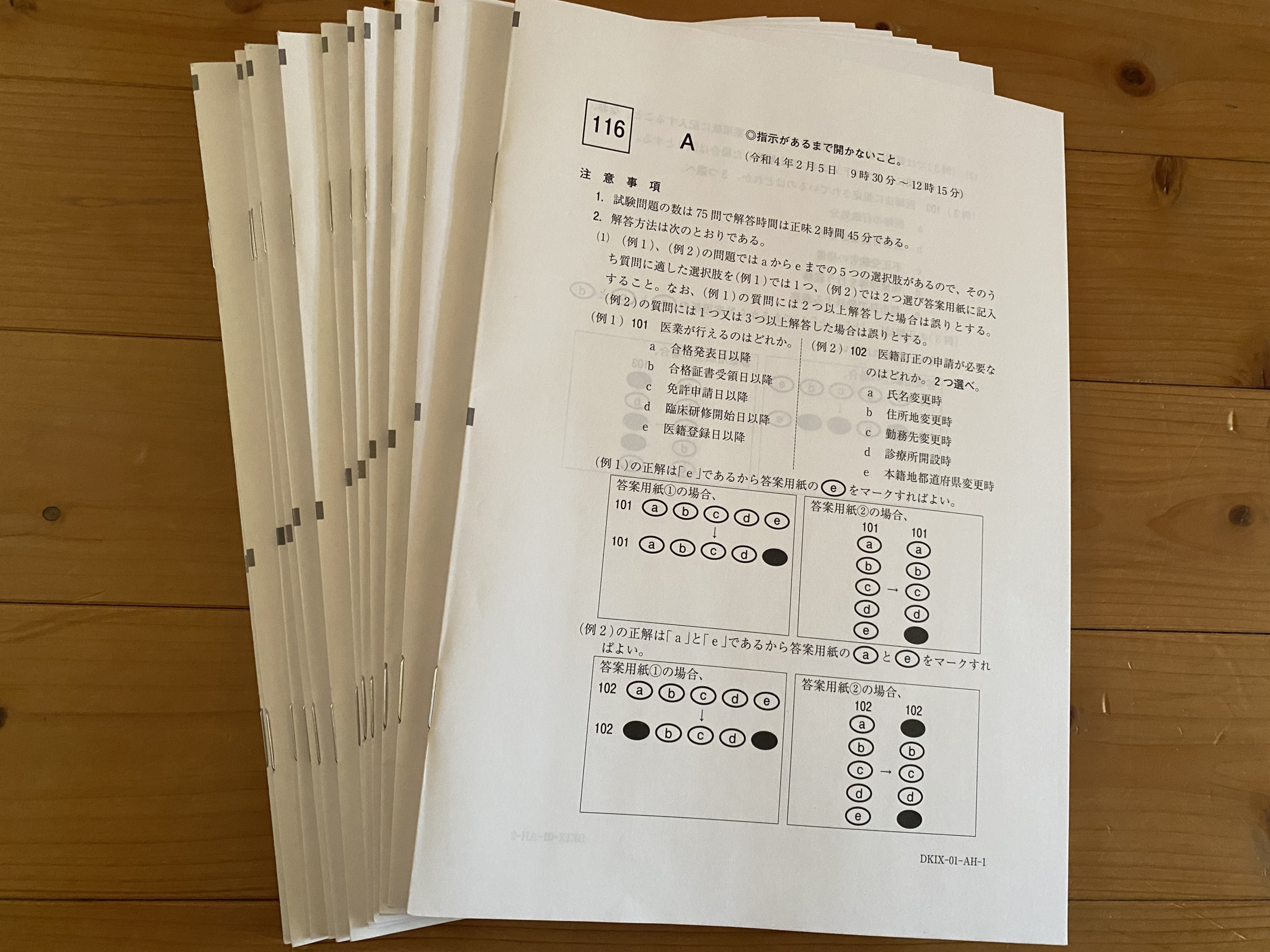Hello everyone. We are now in the season of taking the National Examination.
This time, I would like to talk about the National Examination for Medical Practitioners.
This year, a close friend of mine took the National Examination for Medical Practitioners.
I would like to thank all the students for their hard work. I also want to say good luck to all the students who will be taking the exam to become doctors.
I myself am a graduate student in the medical field, and every year I am interested in what kind of questions were asked on the exam.
The other day, a friend of mine who took the exam showed me the questions and I was able to talk to him directly, so I would like to introduce the 116th National Medical Examination.
Date & Location
This year’s event was held on February 5 (Saturday) and 6 (Sunday), 2022.
The examinations are held over two days in February every year.
There are no additional exams. Every year, it is a one-shot deal. If a student is unable to take the exam, he or she will have to wait until a year later to take it. No such thing.
The national examinations for dentists, nurses, midwives, public health nurses, etc. are also annual exams as well.
As in the previous year, there are still many people infected with the covid-19 this year. I sincerely hope that the government will prepare a system, like the Common Entrance Examination, that allows students to postpone the date of the examination in case they are not feeling well.
I would like to see the Ministry of Health, Labor, and Welfare and experts discuss this issue in the future, as I would like to see students given a chance to take the exam here.
Hokkaido, Miyagi, Tokyo, Niigata, Aichi, Ishikawa, Osaka, Hiroshima, Kagawa, Fukuoka, Kumamoto and Okinawa Prefectures
In Osaka Prefecture, Yamato University was the venue.
Examination details
Knowledge and skills to be possessed as a physician regarding medicine and public health necessary for clinical practice
The Ministry of Health, Labor, and Welfare (MHLW) has only one line of explanation, but the questions are very broad and come from a huge range of fields.
Qualifications of candidacy for an examination
(1) Those who have graduated from a university based on the School Education Law (Law No. 26 of 1947) after completing a regular course in medicine (including those who are expected to graduate by March 10, 2022 (Thursday).
(2) Those who have passed the preliminary examination for the National Medical Practitioners Examination and have undergone practical training in medical practice and public health for at least one year after passing the examination (including those who are expected to complete the practical training by Thursday, March 10, 2022).
(3) Those who have graduated from a medical school in a foreign country or obtained a license to practice medicine in a foreign country, and who are certified by the Minister of Health, Labor and Welfare as having the same or higher academic ability and skills as those listed in (1) or (2), and who are deemed appropriate.
(4) Those who are deemed to have received a medical license under the provisions of the Medical Practitioners Act pursuant to the provisions of Article 17, paragraph 1 of the Cabinet Order on Special Measures for Application of Laws and Regulations Relating to the Ministry of Health and Welfare in Relation to the Return of Okinawa (Cabinet Order No. 108 of 1972), and who have been certified by the Minister of Health, Labor and Welfare.
Subject format
Day 1: Saturday, February 5, 2022
A 9:30 – 12:15 / 165 minutes 75 questions each General: 15 questions, Clinical: 60 questions
(5 choices (1): 61, 5 choices (2): 9, 5 choices (3): 5)
B 13:35 – 15:10 / 95 min 50 questions Compulsory: General: 25 questions, Clinical: 15 questions, Long text (2 consecutive questions x 5): 10 questions
(5 choices: 49, 1 calculation)
C 16:00-18:30/150min/75 questions General: 35 questions, Clinical: 25 questions, Long text (3 questions x 5): 15 questions
5 choices (1): 57, 5 choices (2): 15, 5 choices (3): 2, Calculation: 1
Day 2: February 6, 2022 (Sunday)
D 9:30-12:15/165 minutes 75 questions General: 15 questions, Clinical: 60 questions
(5-limb 1 choice: 60, 5-limb 2 choice: 7, 5-limb 3 choice: 8)
E 13:35-15:10/95 min 50 questions Required General: 25 questions, Clinical: 15 questions, Long Paper (2 consecutive questions x 5): 10 questions
(5 choices: 50 points)
F 16:00-18:30/150 Points 75 Questions Required General: 35 questions, Clinical: 25 questions, Long reading comprehension (3 consecutive questions x 3): 15 questions
(5 limbs and 1 choice: 57, 5 limbs and 2 choices: 13, 5 limbs and 3 choices: 3, 6 limbs and 1 choice: 1, Calculation: 1)
There are 400 questions in total, and by the way, some of them are in English. Both the questions and the answer choices are in English!
Students have to concentrate and do an amazing amount of questions.

Passing mark
- must-have questions 80% or above absolute standard
- general and clinical questions around 70% relative standard About 90% of the students pass the exam.
- less than 3 contraindicated questions Absolute standard
The required and forbidden questions are absolute standards, so you must always exceed these standards in order to pass.
For example, if you answer 98% of the general and clinical questions and all the contraindications correctly, but 75% of the required questions, you will not pass the exam.
Also, even if you answer the required and general/clinical questions correctly, if you get four questions wrong on the contraindications, you will not pass.
In order to become a doctor, a profession that takes care of people’s lives, you absolutely must answer the important questions correctly.
Try to solve the problem
A friend of mine, who had worked hard for six years in medicine and two days of exams, had brought me the exam questions so that I could take a closer look at them. I felt that they must have studied hard for six years. I’m going to try to solve it too.
Excerpt from Question A
Q: What is the appropriate time to start penicillin antibiotics as a preventive measure against mother-to-child infection in a pregnant woman who tests positive for group B streptococcus (GBS) in a bacterial culture of vaginal secretions at the end of pregnancy?
a. At the time of positive test result
b. At 37 weeks of pregnancy
c. At the onset of labor
d At the time of full opening of the uterus
e. At the time of the expulsion of the baby’s head
Which of the following do you think?
It asks for knowledge on how to prevent early-onset Group B Streptococcus (GBS) infections in full-term newborns and is a case that is often encountered in clinical practice. I feel that this is a good question, so I would like to explain it. The correct answer is C.
According to a nationwide survey conducted in Japan from 2004 to 2010, the prognosis of 88 children with early-onset GBS infection was reported to be 12 (13.6%) deaths and 12 (13.6%) residual sequelae. In order to prevent this from happening, we are conducting clinical tests and treatments.
GBS culture test is performed at 35 to 37 weeks of pregnancy to confirm GBS carriage. This is done at the entrance of the vagina during the prenatal checkup.
In addition, intravenous penicillin and other antibacterial agents are administered to prevent infection of the newborn after vaginal delivery or early water breaking in pregnant and nursing women with the following conditions.
1) GBS is identified
2) the Previous child had a GBS infection
3) GBS detected in urine culture during this pregnancy
4) GBS is unknown and more than 18 hours have passed since the water broke, or the patient has a fever of more than 38.0 degrees Celsius.
As for the timing of the culture test, in the past, if the test was done before 34 weeks and was negative, the test may not be repeated (many facilities do two tests). The obstetric guidelines were changed in 2017, so I will explain them accordingly.
In 2017, the obstetric guidelines were changed to state, “The GBS test should be performed at 35-37 weeks of gestation.
The GBS culture specimen should be collected from the vaginal opening with a swab (preferably without a vaginal speculum) and then from the anus with the same swab (or another swab). The CDC recommends a site beyond the anal sphincter for anal collection.
Studies showing efficacy within 5 weeks of the collection have also been done at the same site. On the other hand, it has been reported that there is no significant difference in the positivity rate between the perianal area surface and the area beyond the anal sphincter.
Starting antimicrobial therapy more than 4 hours before delivery in pregnant women with GBS and maintaining blood levels of antimicrobial agents are effective in preventing early-onset neonatal GBS infection.
There is no question about the previous child (older child) on this national exam, but
If the preemie has a GBS infection, it should be treated with antimicrobial agents during delivery as a high-risk group for early-onset neonatal GBS infection, even if it is confirmed to be negative for GBS in this pregnancy.
Therefore, if the previous child has a GBS infection, the GBS culture test can be omitted at 35 to 37 weeks of gestation. A positive urine culture during pregnancy (if done for any reason) should be treated as a positive GBS culture (regardless of the number of weeks) since patients with positive urine cultures for GBS are presumed to have a high level of vaginal-anal carriage.
Even if the GBS carrier status is unknown, if more than 18 hours have passed since the water broke or if there is a fever of more than 38.0 degrees Celsius, the patient is treated as a high-risk group for early-onset neonatal GBS infection.
Prophylaxis is not necessary for scheduled cesarean sections without water breaking or labor pain.
This question asks when to start the administration of penicillin antibiotics.
The answer is C, at the onset of labor.
A is too early.
b is not necessary if labor has not started yet, although the baby will be full-term at 37 weeks. It’s time for a culture test, and you’re confusing me with choices.
And d for full uterine opening and e for the expulsion of the baby’s head, the baby will be born soon, so it’s too late for the medication to be effective.
Preparation for exams
I don’t think I need to go into details here, as everyone has their own way of studying.
The best way to prepare for any exam is to
Take a mock exam to get used to the real thing.
Do at least three rounds of the past five years’ worth of questions. Also, measure your time and do it.
Keep yourself in good shape and concentrate on the actual test. Take the exam with the belief that you will definitely pass.
Lastly, I would like to thank everyone who took the exam. I’m sure there are many things that you have had to endure and many things that you have had to restrict. Please enjoy your spring break until you find a job. I hope you can stretch your wings.
I sincerely hope that you will pass the exam and become a doctor in April.
Thank you very much for reading to the end.
Tomorrow is the national examination for nurses. Good luck to all Nursing students❣






